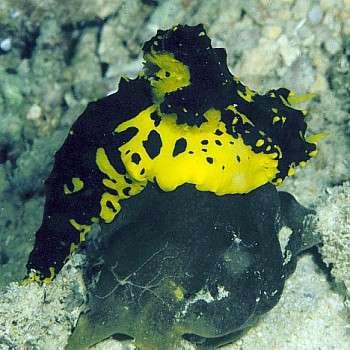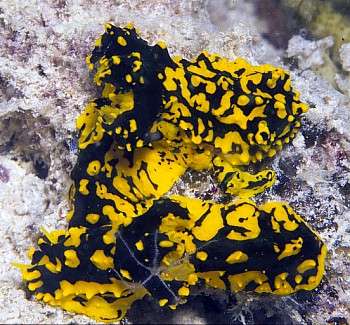Notodoris gardineri from Papua New Guinea
February 11, 2000
From: Mary Jane Adams


Dear Bill,
Although Notodoris minor is common in PNG, especially Milne Bay, I have only seen Notodoris gardineri twice. Both sightings were on night dives on Middle Reef near New Hanover Island in northern Papua New Guinea. This is a silty, coral rubble reef.
The UPPER picture of N. gardineri feeding on a sponge, was taken at 7 meters on Nov. 28, 1996. There was a second one about a meter away. The LOWER photo of a group of three was taken at about the same depth on Sept. 9, l998. There were two others near by. Several things have always puzzled me about this "family portrait." Do you think the brittle star is purposefully hitchhiking, or just there incidentally? Could the tiny nudibranch in the middle be mating with the full sized one? Do nudibranchs have to be full sized to mate? N. gardineri looks very much like a melanistic variety of N. minor. What are the anatomical differences that make them separate species?
Thanks!
Mary Jane Adams
mjadams@earthlink.net
Adams, M.J., 2000 (Feb 11) Notodoris gardineri from Papua New Guinea. [Message in] Sea Slug Forum. Australian Museum, Sydney. Available from http://www.seaslugforum.net/find/1873Dear Mary Jane,
The Notodoris species pages are certainly filling out! Let's look at some of your questions.
•The brittle star question. This certainly raises an interesting point. As your upper feeding photo shows there are species of little brittle stars which are often found on sponges. I don't know if anyone has shown they exclusively live on sponges or whether they are just more easily seen on sponges. If they do live exclusively on sponges then I suppose hitching a ride on a sponge feeder would be a good way to move from sponge to sponge.
•Mating size in nudibranchs. Opisthobranchs are all hermaphrodite which means they have both a male and female reproductive system. Often the male system develops early in the growth of the animal and some species, which we call protandrous, become functional males at a much smaller size than they become functional females. In others both systems are fully mature and working at half the species full adult size. So it is possible that the small Notodoris is a functional male. The only way to be sure would be to have given them a nudge and seen if they were attached to each other.
•Anatomical differences in Notodoris.
Certainly some colour forms of N. gardineri look like very black forms of
Best wishes,
Bill Rudman.
Related messages
-
Black Notodoris gardineri from the Maldives
From: Marcel Tanke, July 28, 2008 -
Notodoris gardineri feeding
From: Jim Anderson, May 11, 2007 -
Notodoris gardineri from West Papua
From: Jim Anderson, May 11, 2007 -
Notodoris gardineri? from Okinawa
From: Kunihiro Takahashi, March 19, 2004 -
Notodoris gardineri from Lord Howe Island
From: W.B. Rudman, January 22, 2003 -
Notodoris gardineri - juvenile
From: Bruce Potter, January 3, 2003 -
Colour change in Notodoris gardineri
From: Julie Marshall, December 5, 2002 -
Juvenile Notodoris gardineri
From: Bill Rudman, November 25, 2002 -
Notodoris gardineri from Sulawesi
From: Mary Jane Adams, May 7, 2002 -
Re: Brittle stars and nudibranchs
From: Gordon Hendler, February 12, 2000 -
Notodoris from Sunshine Coast
From: Wayne Ellis, July 27, 1998
